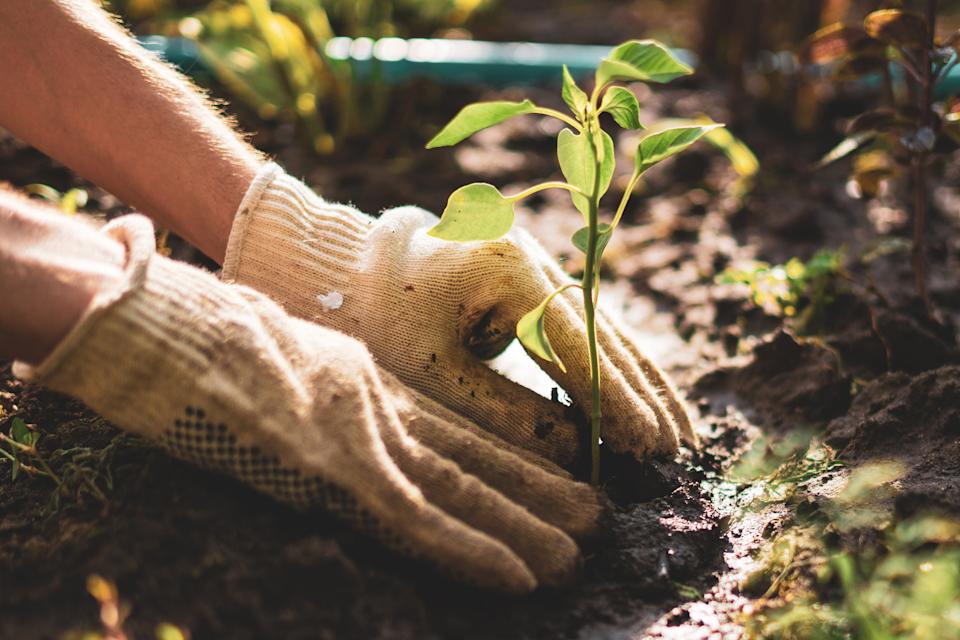Best time of day to water plants, and other beginner gardening questions answered

As we continue to adapt to life under lockdown, many people are discovering a new found love for their garden, if they’re lucky enough to have one that is.
But while suddenly discovered your green fingers, has definitely helped with the lockdown boredom, many of us are wondering how we take the pottering up a notch and actually become a bonafide gardener.
The trouble is we’re not totally sure we really know what we’re doing.
How do you know how much water plants need, the best soil or compost to use and how often you need to cut back (see we’re sounding like gardeners already!)
Read more: Bring the beach to the garden with these deckchairs
Ready to don your gardening gloves, but have some questions?
Here are some of the most common questions that every beginner gardener has (and, of course, the answers).
How do I know what plant is what?
Confused about how to tell your pansies from your perennials? Here’s a quick guide from the RHS:-
Annuals are plants that live for just one year and include cornflowers, field poppies, alyssum, marigolds and cosmos.
Biennials are like annuals but they live for two years, making leaves the first year then flowering and dying the next.
Climbers, as the name suggests, are plants that climb using other plants or objects as support. Think clematis, honeysuckle and the beautiful smelling, jasmine.
Perennials derive from the word ‘perennial’ which means that a plant lives at least three years. Typical examples of perennials include lupins, agapanthus, ornamental grasses and geraniums.
Shrubs are typically woody-stemmed plants, lacking a single trunk. Key varieties include roses, buddleia, lavender, rhododendron and hydrangea.

What do I need in my gardening kit?
Really not that much. According to the RHS the essential wannabe gardeners kit should include a hand fork and trowel, secateurs, border fork, spade and gloves.
They do suggest you keep your kit clean though as “they'll be easier to use, last longer and you’ll minimise the risk of spreading plant diseases.”
You’ll also need compost, seeds or seedlings, and a watering can.
If you want to garden purely in pots you’ll need potting soil to fill it. And whether gardening in the ground or in a container, you'll need compost to provide your plants with nutrition.
When’s the best time of day to water plants?
According to the RHS plant should ideally be watered early in the morning, to avoid evaporation loss during the day.
“On warm summer days, evening watering is also likely to be effective, the dry soil soaking it in readily and low humidity at night reducing risk of disease,” the site adds.
Read more: Best affordable outdoor furniture for your garden
How do I know if my plants need watering?
The RHS suggests inspecting the soil at a spade’s depth.
“If the soil feels damp, there is unlikely to be any need to water, but if it is dry, then watering is probably required for some plants.”
When it comes to pot plants, you need to look to see if the compost looks paler or feels dry to the touch, if so it’s time to get the watering can out.
Another sign your potted plants need watering is spotting the pot becoming lighter in weight (and consequently more prone to blowing over).
How much water do plants need anyway?
Never sure if you’re watering too much or not enough? We hear ya! According to RHS the type of soil often determines how much water is needed. Light sandy soils need watering more often than heavy soils, although less water can be applied at each watering.
Heavier, clay-based soils can be watered less frequently, but need heavier applications of water because they hold more water within their structure.
They also have a handy tip for reducing the amount of water needed. “Water can be saved by applying it to the base of the plant rather than over a wide area,” the site explains. “As a general guide, up to 24 litres per sq metre (5.2 gallons per 10 sq ft) every seven to 10 days will be sufficient to maintain plant growth.”
Read more: How to grow and care for peonies

How do I get rid of weeds?
Weeds are the wannabe gardener’s worst enemy (well that and slugs) because they steal valuable nutrients from the plants you’re trying to grow.
There are many ways to get rid of weeds without resorting to weed killers, but they will involve putting in some weed control groundwork.
According to the RHS some of the methods of weeding involve; hoeing - or running a hoe over a bed or between rows to kill weed seedlings; hand pulling or weeding with a fork, and repeated cutting, which can weaken and even kill some weeds if done over a period of several years.
How do I prune my plants?
And why do they even need pruning? According to the RHS pruning can help to restrict the size of certain plants, remove dead growth and help keep the plant in a healthy state. “Some shrubs, if left unpruned, continue growing from where the growth ended the previous season, becoming top heavy, flowering well above eye level, and with a bare base,” they explain.
The RHS has a complete guide on how to prune your plants and trees depending on their type.



